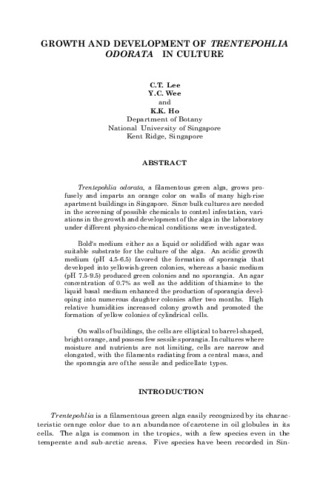Growth and development of Trentepohlia odorata in culture
- Global styles
- MLA
- Vancouver
- Elsevier - Harvard
- APA
- Help
Share
นามธรรม
Trentepohlia odorata, a filamentous green alga, grows profusely and imparts an orange color on walls of many high-rise apartment buildings in Singapore. Since bulk cultures are needed in the screening of possible chemicals to control infestation, variations in the growth and development of the alga in the laboratory under different physico-chemical conditions were investigated.
Bold's medium either as a liquid or solidified with agar was suitable substrate for the culture of the alga. An acidic growth medium (pH 4.5-6.5) favored the formation of sporangia that developed into yellowish-green colonies, whereas a basic medium (pH 7.5-9.5) produced green colonies and no sporangia. An agar concentration of 0.7% as well as the addition of thiamine to the liquid basal medium enhanced the production of sporangia developing into numerous daughter colonies after two months. High relative humidities increased colony growth and promoted the formation of yellow colonies of cylindrical cells.
On walls of buildings, the cells are elliptical to barrel-shaped, bright orange, and possess few sessile sporangia. In cultures where moisture and nutrients are not limiting, cells are narrow and elongated, with the filaments radiating from a central mass, and the sporangia are of the sessile and pedicellate types.
การอ้างอิง
Lee, C. T., Wee, Y. C., & Ho, K. K. (1990). Growth and development of Trentepohlia odorata in culture. In I. J. Dogma Jr., G. C. Trono Jr., & R. A. Tabbada (Eds.), Culture and use of algae in Southeast Asia: Proceedings of the Symposium on Culture and Utilization of Algae in Southeast Asia, 8-11 December 1981, Tigbauan, Iloilo, Philippines. (pp. 55-65). Tigbauan, Iloilo, Philippines: Aquaculture Department, Southeast Asian Fisheries Development Center.
Type
Conference paperISBN
9718511113คอลเลกชัน


